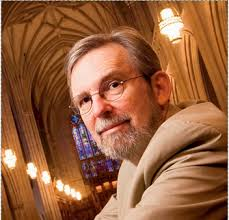Richard B. Hays completed his new book Echoes of Scripture in Gospels (Baylor University Press, 2016) in record time thanks in large part to the heavy-lifting done by Carey Newman and his staff at Baylor University Press. Hays was diagnosed with pancreatic cancer in the summer of 2015 and underwent successful surgery in the fall. He stepped down from his role as dean of Duke Divinity School for medical treatment and used part of his recovery to finish up this book. 
This book extends an earlier project, Reading Backwards: Figural Christology and the Fourfold Gospel Witness (Baylor University Press, 2014). It echoes an even earlier bit of research written up in Echoes of Scripture in the Letters of Paul (Yale University Press, 1993). In the book under review Hays turns his attention to the four New Testament Gospels with similar method and surprising results.
Hays is influenced by Eric Auerbach’s approach to “figural interpretation” in his book Mimesis: The Representation of Reality in Western Literature (Princeton University Press, 2013). Figural interpretation involves linking two texts so that a past person (or event) signifies that person as well as another in the future. The interplay between those two texts brings greater insight to both texts. Each sheds light on the other. It is a way of “reading backwards.” This has nothing to do with past predictions which are “fulfilled” in the future, although there are places when Gospel writers make those kinds of connections as well. At the heart of it is the notion that a text might mean more than a human author ever intended. Once a writer has released his text, later audiences are able to read backwards through significant events/persons in order to see connections to these earlier texts. The NT is awash in figural readings of the OT.
Hays does not spend his time working out and fine tuning a method. In a sense he has done that already in earlier books mentioned above. What he does do is work carefully through many Gospel texts listening for the echoes and helping his readers see and experience these in fresh and exciting ways. One of my favorite examples is in the episode when Jesus walks on the sea of Galilee (Mark 6). Although Mark does not make any explicit biblical allusions, the way he tells the story conjures up certain images from the first part of the Christian Scriptures. In particular, he notes how Mark says Jesus appears to intend to pass them by and ends the pericope with the hanging question: “who is this that the winds and the seas obey?” As Hays says, there is only one right answer to that question. It is found in Job 9, particularly the Greek version (LXX). I won’t spoil the ending completely but Hays and I both think there is a not-so-subtle identification of Jesus with the God who created the land and seas in the first place. Go back and read Job 9 in the Greek and it is apparent.
Hays is an advocate of an early high Christology, compared to the late, slow and low crowd. This means that the earliest evidence we have (the letters of Paul and the NT Gospels) are best read to include Jesus within the identity of Israel’s God. As a charter member of the early high Christology club, I’m glad to make him a full-fledged member.
This is an amazing book. I cannot recommend it any higher. I’m so glad to have it in hand as I’m thinking about a future book I’m working on entitled Matthew through Old Testament Eyes (Kregel, forthcoming 2018 or 2019).

Reblogged this on Talmidimblogging.